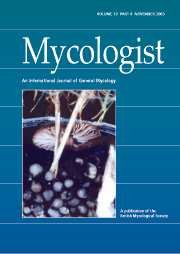Article contents
Teaching techniques for mycology: 21. Sclerotinia, Botrytis and Monilia (Ascomycota, Leotiales, Sclerotiniaceae)
Published online by Cambridge University Press: 18 March 2004
Extract
Names of fungi
1. Sclerotinia curreyana (Berkeley ex Currey) P. Karsten = Myriosclerotinia curreyana (Berkeley ex Currey) Buchwald; conidial state Myrioconium Sydow
2. Sclerotinia Fuckeliana (de Bary) Fuckel = Botryotinia fuckeliana (de Bary) Whetzel; conidial state Botrytis cinerea Persoon ex Fries
3. Sclerotinia fructigena (Persoon) Schröter = Monilia fructigena Honey ex Whetzel; conidial state Monilia fructigena (Persoon) Eaton
Introduction: Features of interest
Members of the Sclerotiniaceae are plant pathogens characterized by stalked apothecia with inoperculate asci. Apothecia arise from stromata, e.g. sclerotia which are formed on or in the tissue of the host plant. The apothecial state and the type of stroma are typical and taxonomically relevant features of the Sclerotiniaceae, and the family has been supported and delimited by DNA sequence data (Carbone & Kohn, 1993; Holst-Jensen et al., 1997a,b).
- Type
- Original Article
- Information
- Copyright
- © 2003 Cambridge University Press
- 2
- Cited by




